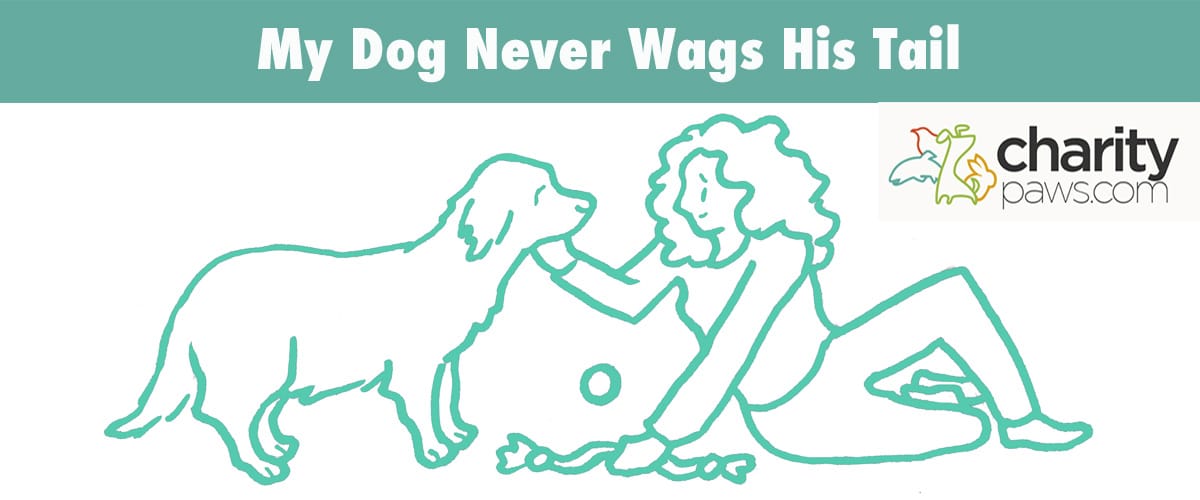Why doesn’t my dog wag his tail?
If this is a question you have asked yourself then it is probably because you have some concerns about your furry friend, after all, dogs are well known for their waggy tails.
There are some circumstances where this might not be the case though.
In this article, we are going to explore normal dog behavior as well as the possible reasons why your dog is not wagging his tail.

Does A Wagging Tail Mean A Dog Is Happy?
Dogs use their body to communicate with each other, and with us.
In many cases, a wagging tail does indicate that your dog is happy or feeling playful.
However, for some dogs, a tail wag can also indicate aggression, arousal, or even nervousness.
This is why it is important to look at the rest of the dog’s demeanor and body language for clues, as well as their tail.
- How is the dog moving and in what direction? Is it bouncy and playfully engaging with you, or are they backing away?
- Does the dog appear relaxed, or are they tense and stiff?
- How are they wagging their tail? Is it stiff and slow, or loose and fast? The latter is more likely to indicate playfulness.
It is important to look at the dog as a whole and not just be guided by a wagging tail.
It is especially important to greet any dog you are not familiar with slowly, speaking in soothing low tones.
For more information see our blog on meeting a dog for the first time.
What Does It Mean When A Dog Doesn’t Wag Its Tail?
There are many reasons why your dog might be reluctant to wag his tail.
Let’s explore each of those in turn.
Breed
Some breeds are naturally waggier than others!
This can be due to their personality but also due to the conformation of the tail.
Dogs with corkscrew-type tails like English Bulldogs or Basenjis may struggle to wag as freely as a retriever for example.
They may sway their bottoms or wiggle around but aren’t able to wag in the true sense of the word.
Other dogs have tails that just hang down or are slightly tucked between their legs, even when they are feeling happy, like whippets.
Know what is normal for your dog, and look at the rest of their body language for clues as to their mood.
Limber Tail
Acute caudal myopathy (also known as ‘swimmer’s tail’ or ‘limber tail’) is a condition that especially affects dogs that like to be in the water.
Dogs use their tails to balance and steer while swimming, so the muscles here are constantly exercised when the dog is in the water.
Swimming in cold weather and overexerting themselves (especially when they haven’t done any intense swimming for a while) can predispose a dog to limber tail.
When the tail muscles have become overworked and strained in this way, they will become uncomfortable, and your dog may have the following symptoms.
- A limp, hanging down tail
- No wagging of the tail
- Pain, especially when you touch or try and move the tail
- Lethargy
- Crying or whining in discomfort
- Licking or chewing at the tail
This condition is mostly seen in working and hunting breeds, especially those that enjoy water such as retrievers and spaniels.
Your vet will examine your dog and may suggest some other diagnostics if they want to rule out other conditions.
Rest and anti-inflammatory pain killers will usually help improve things though.
Injury
As well as limber tail, other injuries could cause your dog to stop wagging their tail.
This includes fractures or dislocations in the tail or damage to the nerves that help to control wagging.
These types of injuries are commonly seen following road traffic incidents or accidents that involve the tail being trapped or crushed (for example in a door).
Sometimes external injuries like cuts or abrasions are seen too, but not always.
If your dog has suddenly stopped wagging their tail or seems in pain, then get them checked over by your veterinarian.
Arthritis
Some animals develop osteoarthritis especially as they age, which can prevent them from moving as freely as normal.
This degenerative condition causes stiffness and inflammation and can affect multiple joints in the body.
This can help to explain why your elderly dog may not be able to wag as enthusiastically as he once could.
Other types of arthritis can affect younger animals such as autoimmune disease.
As well as not wagging their tail, they may show other signs like fever, inappetence, lameness, or back pain.
Stress or Anxiety
Behavioral problems could cause your dog to stop wagging his tail.
As we know, many dogs will wag their tail when they are feeling happy and relaxed.
If your dog is feeling the opposite of this, then he may be too tense to wag and may show other signs of unhappy body language too.
These include:
- Tense posture
- Cowering or backing away
- Trembling
- Barking or growling
- Panting excessively
- Yawning more than usual
- Licking their nose excessively
- ‘Whale eyes’ – showing the whites of their eyes
- Not interested in treats or food
This behavior can be seen because of phobias like fireworks or thunderstorms, but it can also be seen in animals who have had past trauma, such as rescue dogs.
This can take time and professional help to unravel and build your dog’s confidence up again.
Seek help from your veterinarian and a qualified pet behaviorist if you have concerns about your dog’s behavior.
Spinal Issues
Dogs that suffer from spinal issues can struggle to move their tails effectively.
There are different causes of spinal problems in dogs including injury, cancer, arthritis, but also disc disease.
Certain breeds are more prone to intervertebral disc disease than others including dachshunds and Bassett hounds.
Different degrees of problem can occur from mild loss of sensation in the hind legs and tail, through to complete paralysis.
Treatment depends on the severity of the problem, sometimes conservative measures like anti-inflammatories and rest can be effective but other times spinal surgery is required, which usually requires a veterinarian who specializes in this area.
Docked Tail
Animals with docked tails will struggle to wag and communicate as a normal dog would.
They may be able to wiggle their tail stump and their bottom, but movement may be limited.
Some dogs will be docked for medical reasons, usually having an amputation of their tail due to a severe injury or perhaps a tumor.
Sadly though, the majority of dogs with docked tails have been done to conform to ideals about the way certain breeds should look.
The Humane Society classes this as an unnecessary and cruel cosmetic procedure, alongside ear cropping and devocalization (debarking).
Some countries have now made tail docking illegal, except for certain circumstances (i.e specified working breeds or medical grounds).
My Rescue Dog Never Wags His Tail, Why Is That?
As we touched on previously, some dogs don’t wag their tails because of behavioral problems.
If your rescue dog has had a poor start in life, due to abuse, neglect, or lack of appropriate socialization then he may be anxious in certain situations.
This may be especially obvious during the settling-in period when your dog is trying to adjust to his new home.
Many dogs will gradually improve and become happier and more confident as they get used to your family and routine.
But if your dog seems to be struggling then speak to your vet and a qualified behaviorist for help.
Will My Dog Ever Wag His Tail?
The answer to this question very much depends on the reason why he’s not wagging his tail in the first place!
Many of the issues that we described earlier will resolve with time and the right treatment.
This will depend on your vet’s diagnosis, but a course of anti-inflammatories may resolve a problem like limber tail, or surgery if there is a spinal problem.
However, some conditions may mean your dog never wags his tail well again.
Severe tail injuries or having a docked tail may impede your dog from ever having a natural wag.
Remember too, that some breeds are just not naturally waggy!
If your dog had a waggy tail and this has suddenly changed, then it is important to get him checked over by your veterinarian as soon as possible, especially if he is also subdued, seems painful, is limping or there is an obvious injury.
Conclusion On Dogs That Never Wag Their Tails

If your dog never wags his tail, then there could be a good reason for this.
Sometimes it is something obvious like his breed or the conformation of his tail (corkscrew or docked tails don’t wag very easily!).
But it could also be due to injury, degenerative illnesses, or behavioral problems.
If your dog used to be waggy but has suddenly stopped then get him to a vet as soon as possible for a thorough check over.

